Université de Bordeaux researchers Claudia Nioi and Rémy Ghidossi, along with Maria Tiziana Lisanti of the Università degli Studi di Napoli Federico II, used Pinot Noir for the experiment. They filtered 35% of the free-run juice and stored it at 10°C until the fermentation was under way. Then the nanofiltration permeate was reintroduced at three differents moments: density of 1060 (tank 1), at 1030 (tank 2) and 1000 (tank 3). The objective was to evaluate the impact of the moment (density: 1060 or 1030 or 1000) of reintroduction of the permeate on polyphenols extraction.
The researchers found that the nanofiltration treatment and reintroducing the free-run juice in the middle of the fermentation (1030) was the most effective strategy for promoting the gradual extraction of anthocyanins and their stabilisation by tannins.
The researchers suggest this strategy could also be applied to the extraction of colouring matter from hybrid grape varieties with low colour potential.
Since the study was first published in the International Viticulture and Enology Society’s journals, Oeno One and IVES Technical Reviews, the researchers have been contacted by winemakers in Australia and France who plan to repeat the experiment this year.
Summary of the study
Nanofiltration: an alternative to thermovinification to increase extraction of polyphenols during winemaking?
Sourced from the research article 'Nanofiltration process as non-thermal alternative to thermovinification in Pinot noir winemaking' (OENO One, 2020)
By Claudia Nioi, Maria Tiziana Lisanti, Rémy Ghidossi
Free-run juice (‘saignée’) from Pinot Noir must was filtered by nanofiltration (NF) and then, with the aim of promoting the diffusion of anthocyanins, the retentate fraction (the fraction that does not pass through the membrane) was returned to the tank immediately and the permeate fraction (the fraction that passes through the membrane) was returned at different densities during the alcoholic fermentation. This extraction strategy was compared with thermovinification (TV). The results obtained demonstrate that NF shows promise as an alternative non-thermal strategy.
Background
Polyphenol content is a major factor contributing to the quality of red wines, as it is responsible for their colour (anthocyanins) and sensory properties (tannins). These compounds are found in grape skins, and diffuse into the must during maceration and then fermentation. In general, anthocyanins are extracted during the first phase of vinification (in an aqueous medium) and subsequently re-adsorbed on the grape pomace, while the extraction of tannins increases as the alcohol content rises during fermentation. The speed of polyphenol extraction and the quantity extracted are difficult to predict, as they depend on many parameters related to the grape variety and the vinification method. Several techniques to increase polyphenol extraction are currently used, including thermovinification and flash release. However, these processes have the disadvantage of being expensive and requiring high temperatures that can have a negative impact on wine aromas. The development of sustainable strategies for improved extraction of polyphenols is therefore a major issue for the wine industry.Experimental method
For the microvinifications, 30kg of ripe, healthy Pinot Noir grapes were destemmed, crushed, and sulfited at 5g/hL. 35% of the juice was then bled from the tanks (a proportion designed to limit fouling phenomena during NF). This study did not include pre-fermentation maceration, to ensure that only extraction during TV was taken into account. For the NF trials, the juice was filtered through an NF membrane (200-400 Da). The retentate, rich in polyphenolic compounds, was immediately returned to the tank. The permeate, low in polyphenols, was stored at 10°C (for microbiological stability) and returned to the cap of grape pomace at three different stages during the alcoholic fermentation, corresponding to the following densities:- 1.060 g.cm-3 (NF1060),
- 1.030 g.cm-3 (NF1030),
- and 1.000 g.cm-3 (NF1000).
For the TV trial, the crushed and destemmed grapes were heated in tank at 80°C for 30 minutes. The fermentation then took place in the liquid phase, to avoid extraction of polyphenols from the pomace during vinification.
For both the NF and TV trials, fermentation was triggered by inoculation with S. cerevisiae strain F33 (Laffort) at 20g/hL and the temperature was maintained at 25 ± 3°C. Changes in the Total Polyphenol Index (TPI), colour intensity and anthocyanin concentration were measured as the alcoholic fermentation progressed. To assess the reactivity and the degree of polymerization of the tannins, the gelatin and dialysis indices were also measured. The impact of the treatments on sensory characteristics was assessed by a panel of eight expert judges who rated the wines using a scale of 1 (low) to 5 (high) points.
Influence of the treatments on overall polyphenolic composition and sensory analysis
The impact of the NF and TV treatments on polyphenol extraction (TPI, anthocyanins and colour intensity) was assessed throughout the alcoholic fermentation (Figure 1, A, B, C). All the analyses described were carried out in duplicate on two vinification replicates and the results reported as the mean ± standard deviation. The existence of significant differences between each NF and TV treatment was estimated by calculating the 95% confidence intervals of the difference between the means. The results show that the polyphenol content (TPI and anthocyanins) is stable for the thermovinification trial and higher for the NF1030 treatment (addition of permeate midway through fermentation and hence in the presence of alcohol).In this case, the diffusion of polyphenolic compounds is affected by the increase in alcohol content throughout fermentation and by the increase in the concentration gradient of the polyphenols between the pomace and the fermenting must resulting from the addition of permeate. The permeate is an aqueous phase, which favours extraction of anthocyanins.
The TV trial, in which the grapeskins are damaged, favours extraction of anthocyanins in the must. Their concentration drops rapidly due to the absence of stabilizing tannins (more easily extracted in a water-alcohol medium). Regarding the change in colour intensity (Figure 1, C), it is stable for TV and comparable to the NF treatments.
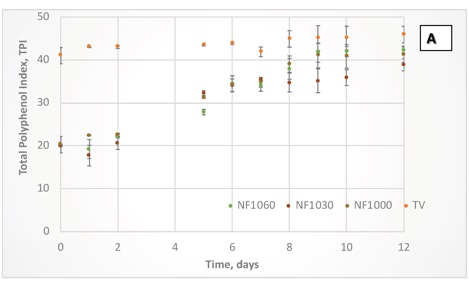
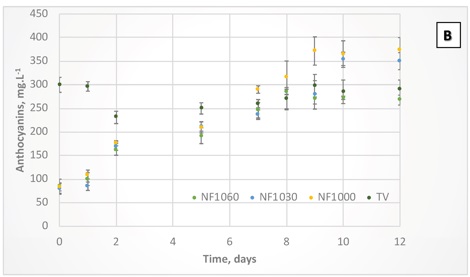
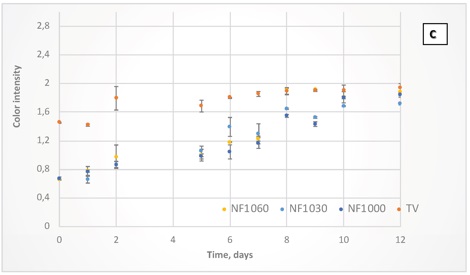
Figure 1. Change in polyphenol content (A: TPI, B: Total anthocyanins, C: Colour intensity) during alcoholic fermentation after TV and NF treatment). The values reported are the mean ± standard deviation of the three analyses for each vinification. (Adapted from Nioi et al, 2020).
The tannin analyses (Figure 2, below) show that the content is higher for the NF1030 and NF1000 treatments. An increase in tannin extraction can be very positive for a Pinot Noir wine, to improve its colour stability. The dialysis and gelatin indices are lower after the NF1030 and NF1000 treatments, i.e. with addition of permeate at the end of fermentation. The NF1060 treatment is comparable to TV. These indices are related to the structure of the tannins and their degree of polymerization. The gelatin index generally correlates with the perception of astringency.
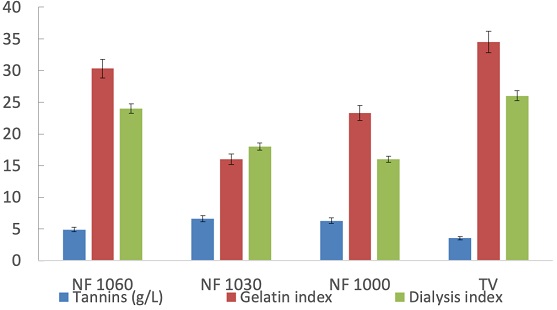
Figure 2. Tannin content and gelatin and dialysis indices of the wines after the different treatments (TV and NF). The values reported are the mean ± standard deviation of the three analyses for each vinification.
These results are in line with the sensory analysis. Overall, the judges gave higher ratings to the wines resulting from NF treatment (4.5 points out of 5 for NF1060 and 4 out of 5 for NF1000 compared with 4 out of 5 for TV) and, in particular, NF1030 (5 points out of 5) (Figure 3).
NF treatment and the reintroduction of permeate in the middle of fermentation probably promotes the gradual extraction of anthocyanins and their stabilization by tannins. This chemical composition has an impact on the taste balance of the wine, which is judged to be less astringent (in line with the gelatin index) and less acidic. The higher score for acidity in the wines from the other treatments may also contribute to increasing the sensation of astringency. Further studies on the specific polyphenolic composition of wine after NF treatment will help to better explain the impact of this new process and optimize its implementation.
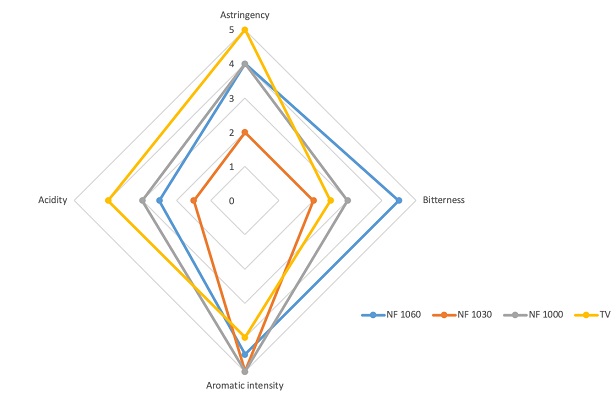
Figure 3. Sensory profiles of the wines after the different treatments. (Adapted from Nioi et al, 2020).
Conclusion
This study shows the potential of a new process for polyphenol extraction using nanofiltration. This innovative process achieves performance comparable to thermovinification in terms of anthocyanin extraction, tannins and colour intensity. The timing of NF permeate addition during alcoholic fermentation has a significant impact on the quantity and quality of the polyphenols extracted as well as the organoleptic profile of the resulting wines. The results show promise for the development of this alternative to thermovinification.This type of approach could be used to achieve different organoleptic profiles depending on the timing of the permeate addition. In addition, this strategy could be applied to the extraction of colouring matter from hybrid grape varieties with low colour potential. Furthermore, this technology satisfies the requirements of a sustainable process, with its energy consumption of 0.8 kWh/hL compared with 11.6 kWh/hL for the thermal process.
Application at a larger scale has confirmed these results. Studies to optimize the process and its impact on the extracted polyphenolic component are planned. They will allow the choice of membrane (material and cut-off threshold) to be adapted, to scale up the process by limiting fouling and the retention of compounds of organoleptic interest.


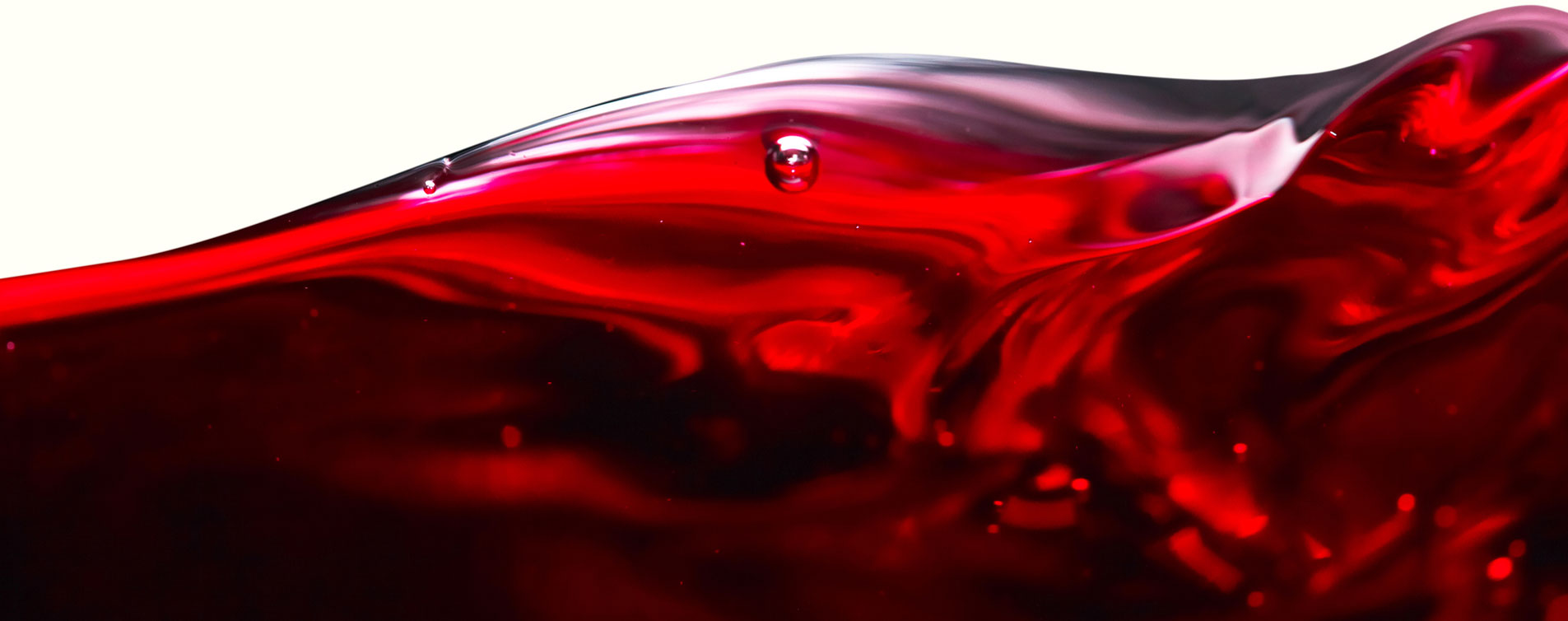










.png)






